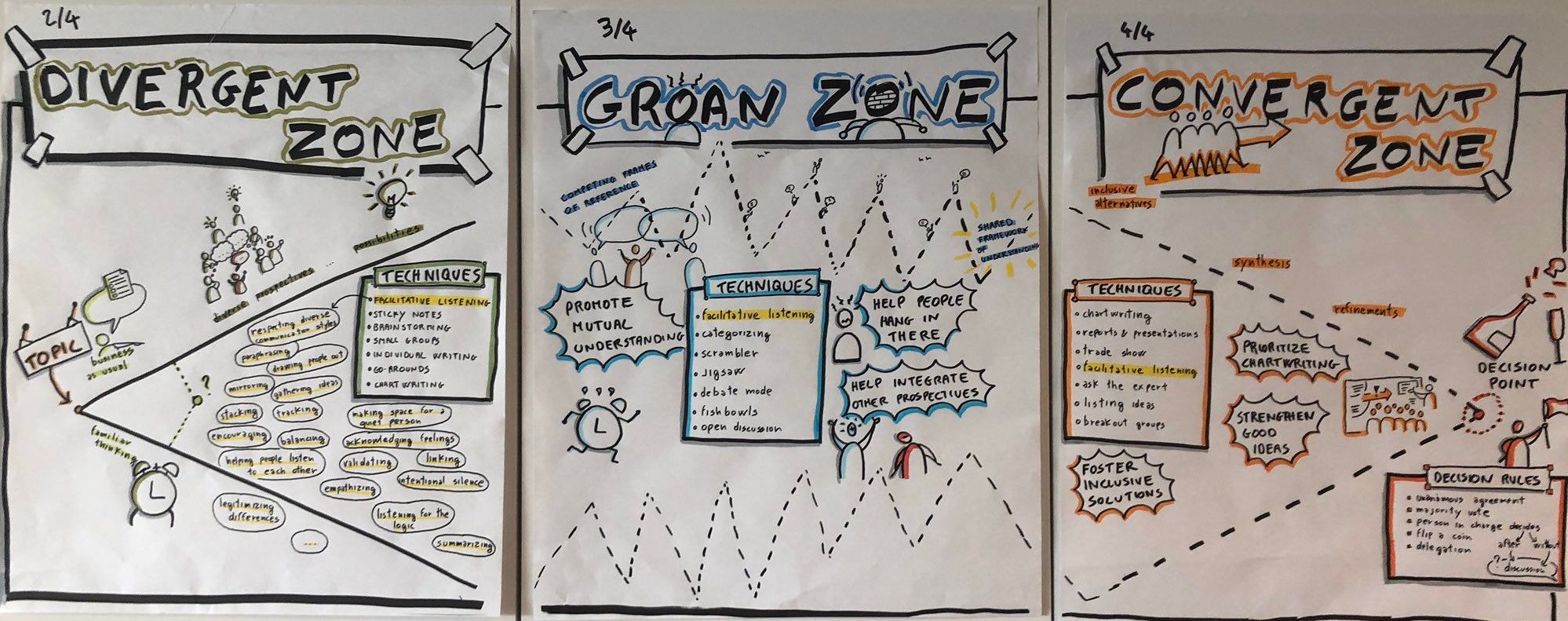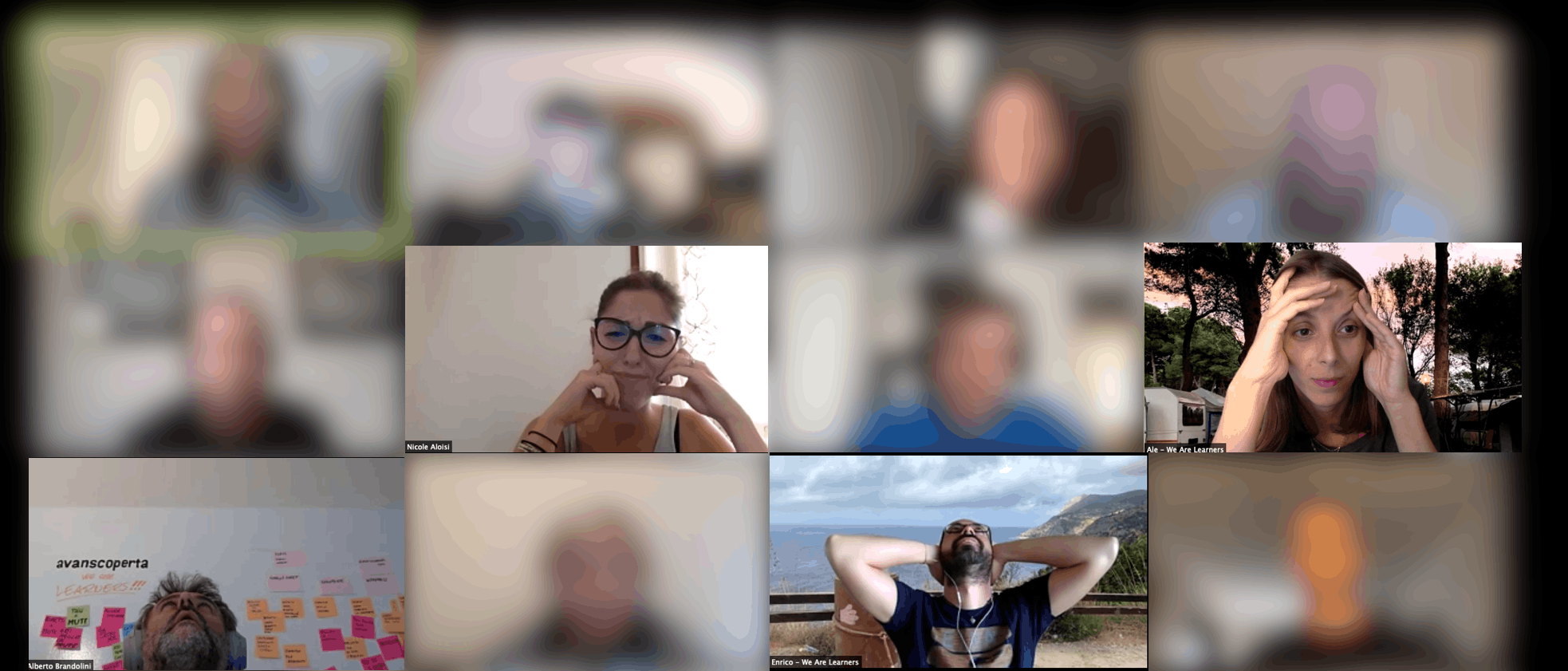Online facilitation: the role of the facilitator
Guiding the group online
This last post of the series focuses on the role of the facilitator guiding the group online.
I wrote separate articles on:
- importance of a session design with the purpose/outcome clarifying the why/who/what/how questions
- what’s the structure for an effective online conversation
- the online lay of the land, what to pay attention to when preparing an online session.
Your mandate
I assume your mandate is to facilitate the conversation and you do not have a stake in it.
If you do have a stake in the topic at hand and the goal of the session is more than business as usual, you’ll have to pay extra attention to your bias. Some ways to manage that are:
- to use a virtual background, visual effect or, assuming you have videos on, wear or hold something to indicate when you’re talking as “Enrico the product manager” instead of “Enrico the session facilitator”
- to switch the facilitator role at regular cadence (requires the whole team to be willing to facilitate and familiar with what a facilitator does)
- to co-facilitate (you’ll have to brief your partner about the session beforehand)
- to admit you’re gonna be better off with an external facilitator, perhaps from another team in your organization.
Online facilitator functions
What are the functions of an online facilitator? Looking at Kaner’s guide, the facilitator’s four functions are to:
- encourage full participation
- promote mutual understanding
- foster inclusive solutions
- cultivate shared responsibility.
Being aware of where your group is coming from both contextually and technically is important to encourage full participation online. Empathize with folks that are less tech savvy or having technical difficulties. Prepare with tools that fit the technical context of your group.
Non-verbal communication
When you’re facilitating online with a group larger than 5 or 6 people, it’ll be hard to keep track of facial cues. Set up team agreements for non-verbal communication will help encourage full participation.
It’s important to have a system for non-verbal communication so people can send cues without “taking over” the one audio channel you share. Have a way for individuals in the audience to indicate when they need a break, want you to slow down or go faster, have questions, or express confusion. Some video call tools offer that, if not you could have a space on your shared document to express that. Make sure you check the non-verbal communication space at regular cadence. For raised hands, take a note of the order so that you can stack the contributions.
Facilitative listening
Non-verbal communication still needs a facilitator to help the group listen to each other. Some techniques are:
Stacking
- To help people take turns when many want to speak at once
- it lets folks know they are going to have their turn, so instead of cutting each other off they can listen to each other
- for example: you have Lisa’s raised hand in the non-verbal communication section, and Luke and Lucy just started simultaneously talking over each other. As the facilitator, you have the right and mandate to intervene and say something like “It’s great that we have all those ideas coming in, I saw Lisa’s raised hand in the non-verbal column. Let’s hear from her first then Luke and then Lucy.”.
Encouraging
- To create a participatory environment without putting pressure on one individual
- some prompts are: “Who else has an idea?” wait 20 seconds - “Are there any comments perhaps from someone that hasn’t spoken for a while?”.
Balancing
- To help a group broaden their discussion, reveal and include other perspectives that didn’t come out yet
- some prompts are: “Are there other ways to look at this issue?”
- it’s good practice to switch from synchronous questions to timeboxed asynchronous ones with silent activities. Giving a prompt and giving people time to reflect on it and writing down their responses. The asynchronous part can happen with a chat, document, or digital whiteboard approach.
Digital constraints
If you have 6 people on a call, only one person can talk at the time and while talking that person keeps everybody else “prisoner”. The role of the facilitator is to encourage full participation, so preventing folks from overtaking the stage is important.
My point is that if someone is talking I can’t simultaneously whisper to Luke, perhaps allowing the emergence of something interesting. To address that, we have to be more intentional and create spaces to also promote mutual understanding.
Moving away from open conversation
Having mutual understanding is a stepping stone to any sustainable next step.
Let’s assume we have 13 people and as a facilitator you picked up two main points of contention: A and B. After confirming with the group what you picked up, it’s your responsibility to guide the group out of open conversation with a more structured technique.
One way could be to transition from open conversation to silent activities--mentioned in non-verbal communication above--and there are other techniques to encourage full participation and promote mutual understanding. Here’s two.
Fishbowl
With this technique you put group A in the fishbowl, timebox n minutes. They are allowed to talk while group B just listens and takes notes. After the time is up, you let everyone ask questions and comment. You then repeat with group B in the fishbowl.
Small groups
This technique puts people in smaller groups for a certain amount of time. Group A and B will discuss their points separately, collect thoughts on a document or digital whiteboard. Then one person stays and the rest of the group “visits” the other space.
Some audio/video tools have breakouts functionality included in their feature set, this allows to break the group into smaller groups within the video call app.
If your video call app doesn’t provide that, prepare separate meeting URLs for the breakouts before your session.
Tip: As you step into longer sessions, more participants and breakout groups evaluate how resilient you are to people getting lost. I like to have a text-only chat--sometimes referred to as backchannel--where all the session participants can ask for help.
Tip: Assume people will get lost, ask yourself how are they gonna come back? How many steps? Be empathetic with folks that are not very tech savvy.
Guiding the group through divergence and convergence

As a facilitator you’re the group’s guide, helping people hang in there during difficult conversations and reach inclusive solutions. The “decide what to do” part of the structure described here is the appropriate moment to do that.
The structure I talk about here helps shape the session but your flight plan still needs a pilot to handle unforeseen events.
Picking up the group’s energy via video and non-verbal feedback is important.
Acknowledging that long online sessions are tiring and calling for breaks. The latest neuroscience tells us about system1/system2 and how much more powerful our subconscious is. Take breaks especially before making decisions to make the most out of that power.
Be comfortable with your setup
When online with a group larger than 6, it’ll be hard to keep track of chat, digital board and faces (assuming cameras are on).
I recommend having at least 3 monitors or enough screen real estate to avoid constant window switching and clicking around.
My setup is one 27’’ Acer to see the group, one 27’’ Acer to see the shared space and one--my laptop 13’’ screen--for the chat. This helps me to keep better track of what’s going on and avoid windows switching.
Working on a single 15’’ laptop would require constant window switching, making you choose between looking at people or at the shared space.
Some people claim you can't read people online.

I think we get the cue on what the people in that photo are thinking. It would be hard to catch that moment if you need to switch between their faces and other windows. With a dedicated window or screen, picking up facial cues gets easier.
Ask for help
Having more screen real estate can increase your capacity but eventually you’ll need a human to help keep track of what’s going on. Everybody is a little different; when I have between 10/15 people I ask for co-facilitation or someone to at least help steward the session. Stewarding helps solve technical problems, or if you’re using a tool they can help answer those questions and let you--the facilitator--focus on the facilitation.
If you’re not an external facilitator but a product manager scrum master, maybe before the session you can ask if someone on the team would like to help with some little tasks.
Conclusions
In anything more than business as usual, meetings preparation makes the difference between a purposeful engaging session and a tedious death march.
If you are asking for the session--ie. a project kickoff meeting--it’s your responsibility to prepare a clear purpose and outcome to be meaningful for the participants. For business as usual meetings--ie. status update, iteration planning--you might already have a structure to follow and less need to prepare and just lightly facilitate an open discussion.
During the session, a facilitator should encourage full participation, promote mutual understanding, foster inclusive solutions, cultivate shared responsibility. Ensure non-verbal communication standards are established, detect your location in the diamond of participatory decision-making and when you need to guide the group from open conversation into other formats (fitting your digital constraints).
If you have a stake in the topic, it’s important to realize when it’s time to ask for help.
I hope this post gave some insights, what are some things you’re gonna try? Or issues you might have when trying?
Wanna go back to the first blog post of this series? Here you go: Online facilitation: session design.
Further Readings
- Sam Kaner’s book Facilitator's Guide to Participatory Decision-Making is in my opinion a bible for facilitation and, regardless of your role, you’ll get a lot out of it.
- A talk by Linda Rising on System 1 / System 2, Thinking fast and slow https://www.youtube.com/watch?v=XjbTLIqnq-o
Learn with Enrico Teotti
Enrico is the author of Online Facilitation Praxis Camp.
Check out the full list of our upcoming training courses: Avanscoperta Workshops.
